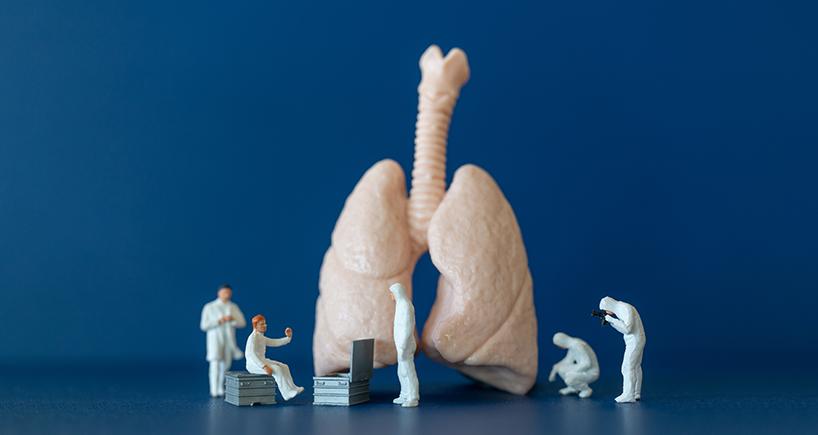
Breath of Hope: Navigating the Journey through Lung Cancer
Lungs are a pair of spongy, air-filled structures situated within the thoracic cavity that facilitate the exchange of oxygen and carbon dioxide during respiration. However, this process gets disrupted with the advent of lung cancer — a malignant neoplasm characterized by uncontrolled cell proliferation within the lung tissues. If not detected during the initial stages, the cancer can spread to the surrounding tissues (known as metastasis) and lead to severe consequences.
Globally, lung cancer is one of the leading causes of cancer-related deaths. In India, it accounts for 5.9% of all cancer cases and 8.1% of cancer-related deaths. Let’s delve deeper into the disease, exploring its causes, symptoms, stages and preventive measures.
Causes of lung cancer
While most cases of lung cancer result from tobacco consumption, some other causes include:
- Occupational exposure to carcinogens (substances capable of causing cancer) such as asbestos, radon, arsenic and uranium.
- Inhalation of toxins when exposed to polluted air, especially from particulate matter emitted by vehicle exhaust and power plants that burn fossil fuels.
- Predisposition to other diseases such as chronic obstructive pulmonary disorder and asthma.
- Genetics or family history.
Symptoms of lung cancer
The disease often goes undetected during the initial stages, as it doesn’t have specific manifestations. However, some signs that could be an indicator of lung cancer include:
- Persistent cough for three weeks
- Frequent lung infections
- Blood in the cough
- Pain while breathing or coughing
- Extreme fatigue
- Sudden loss of weight and appetite
Lung cancer may also manifest as recurrent pneumonia episodes or the enlargement of lymph nodes situated between the lungs.
Types of lung cancer
Lung cancer is primarily classified into two categories: small cell lung cancer (SCLC) and non-small cell lung cancer (NSCLC). NSCLC is the most commonly occurring form of the disease.
Diagnosis of lung cancer
Depending on the severity, healthcare providers may recommend certain diagnostic tests to determine the type and stage of lung cancer. The general process of diagnosing lung cancer involves:
- Physical examination
- Imaging (such as chest X-rays, CT scans and MRIs)
- Bronchoscopy to examine the lungs.
- Biopsy for histopathology (analysis of the tissues) and subtype identification (NSCLC or SCLC)
- Molecular testing for detecting genetic mutations or biomarkers.
Stages of lung cancer
Lung cancer is categorized into different stages depending on the extent to which it has spread. They include:
Stage 0: The cancer is small and hasn’t spread to lymph nodes or other distant organs.
Stage I: The cancer is in the lung tissues, but it hasn’t spread to the lymph nodes.
Stage II: Cancer cells have metastasized to the lymph nodes.
Stage III: The cancer metastasized further into the lymph nodes and reached the middle of the chest.
Stage IV: Cancerous cells have spread outside the chest, reaching the brain, bones, liver and other organs.
The diagnosis of lung cancer at stages I and II accounts for merely 26% and 8%, respectively, while 28% and 38% of the cases are identified at stages III and IV.
Treatment of lung cancer
The treatment approach for lung cancer depends on its stage. Advanced surgical techniques for early-stage lung cancer have emerged recently, utilizing minimally invasive approaches. Procedures such as laparoscopic robotic surgery and video-assisted thoracoscopic surgery (VATS) are breakthroughs in treating stage I and II NSCLC. Apart from surgery, other treatment options include:
- Radiotherapy (radiation)
- Chemotherapy
- Targeted therapy
- Immunotherapy
Prevention of lung cancer
The World Health Organization underscores smoking cessation as the foremost measure to prevent lung cancer. Some other risks to mitigate include avoiding secondhand smoke, minimizing exposure to polluted air and addressing workplace hazards like chemicals and asbestos. Some additional measures to prevent and manage lung cancer include:
- For those diagnosed with lung cancer, symptom progression can be prevented by seeking immediate medical attention and ensuring regular follow-ups.
- High-risk individuals should undergo regular screening before symptoms emerge. Low-dose helical computed tomography (LDCT) is a technique that’s used to screen for such people.
- It’s crucial for adolescents to avoid tobacco, as it can make them highly susceptible to lung cancer.
Ensuring a proper diet, maintaining a healthy body weight and regular exercise will reduce the overall risk of lung cancer.



















